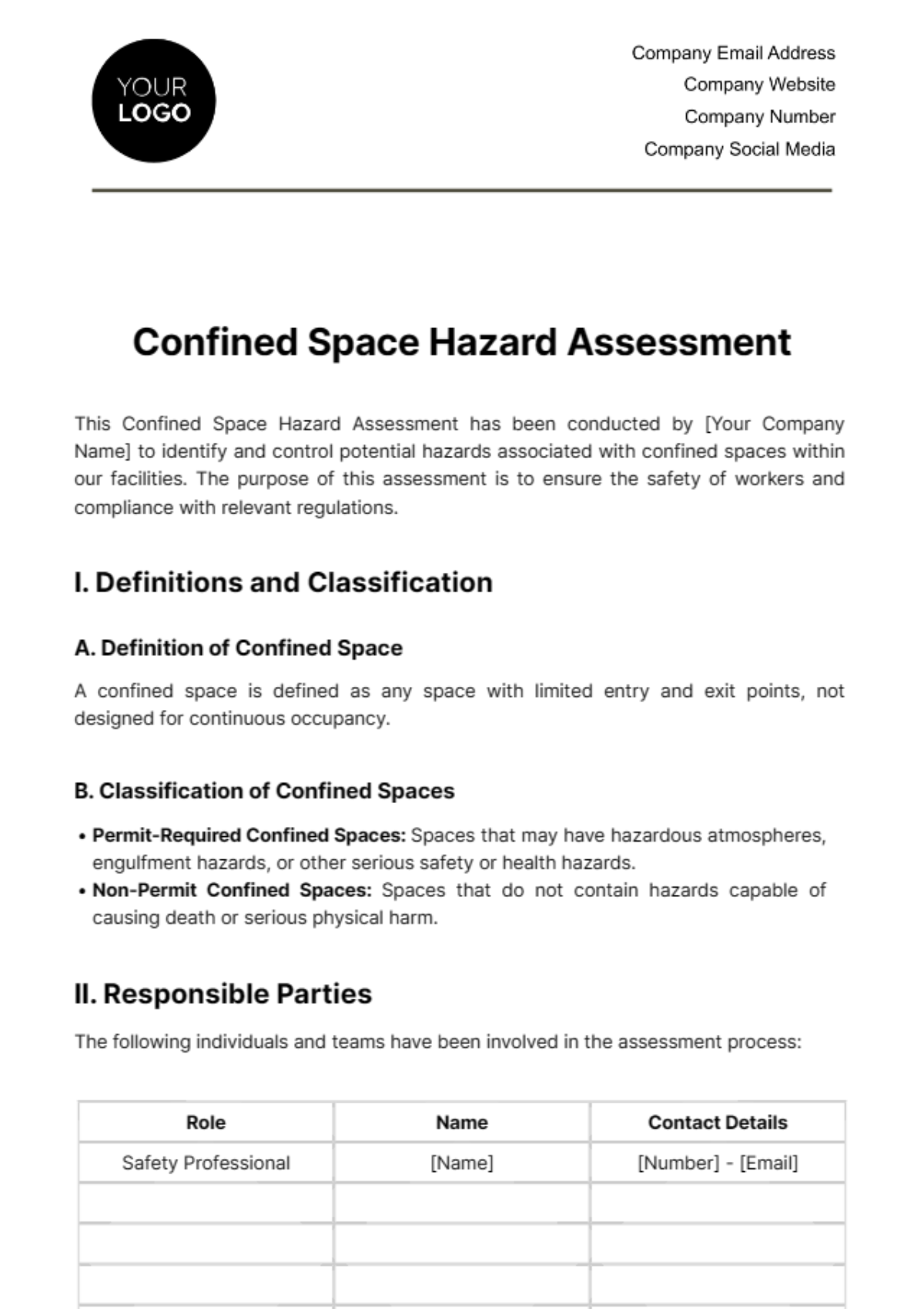Free Confined Space Hazard Assessment

This Confined Space Hazard Assessment has been conducted by [Your Company Name] to identify and control potential hazards associated with confined spaces within our facilities. The purpose of this assessment is to ensure the safety of workers and compliance with relevant regulations.
I. Definitions and Classification
A. Definition of Confined Space
A confined space is defined as any space with limited entry and exit points, not designed for continuous occupancy.
B. Classification of Confined Spaces
Permit-Required Confined Spaces: Spaces that may have hazardous atmospheres, engulfment hazards, or other serious safety or health hazards.
Non-Permit Confined Spaces: Spaces that do not contain hazards capable of causing death or serious physical harm.
II. Responsible Parties
The following individuals and teams have been involved in the assessment process:
Role | Name | Contact Details |
Safety Professional | [Name] | [Number] - [Email] |
III. Types of Confined Spaces and Associated Hazards
A detailed inventory of confined spaces has been compiled, including the following information:
Confined Space Type | Description | Identified Hazards |
Storage Tanks | Closed containers for storing liquids. | Oxygen deficiency, toxic fumes. |
Silos | Tall, tower-like structures for grain. | Dust inhalation, entrapment. |
Tunnels | Underground passageways. | Poor ventilation, collapse risk. |
Pits and Ditches | Excavated areas at worksites. | Fall risk, flooding. |
Sewers | Underground waste disposal systems. | Toxic gasses, biological hazards. |
IV. Risk Assessment and Mitigation Strategies
Risk Level Assessment: Each type of confined space presents unique risks, ranging from low to high. It is essential to conduct regular risk assessments based on the specific characteristics of the confined space.
Mitigation Strategies: Key strategies include proper ventilation, continuous atmospheric monitoring, adequate training for workers, and ensuring appropriate personal protective equipment (PPE) is available and used.
V. Control Measures
We have incorporated robust engineering measures such as ventilation systems and isolation techniques. Administrative controls, including permit systems and ongoing training, reinforce safety protocols. Personal protective equipment is tailored to each confined space, and clear communication and emergency response plans further enhance our comprehensive safety framework.
VI. Confined Space Entry Procedures
Our confined space entry procedures prioritize safety through a meticulous permitting process, comprehensive isolation procedures, and strict atmospheric testing protocols. Lockout/tagout procedures for equipment and two-way communication systems further bolster safety. Our emphasis on procedural precision aims to mitigate risks and ensure the well-being of all personnel involved in confined space activities.
VII. Training and Awareness
Our commitment to safety is reinforced through continuous education and training programs, equipping personnel with the necessary skills for confined space work. Regular drills and ongoing communication strategies enhance awareness, fostering a proactive safety culture. This approach ensures that our workforce is well-prepared and vigilant in managing confined space challenges effectively.
This Confined Space Hazard Assessment is a living document that will be regularly reviewed and updated to ensure the ongoing safety of all personnel working in confined spaces at [Your Company Name].
- 100% Customizable, free editor
- Access 1 Million+ Templates, photo’s & graphics
- Download or share as a template
- Click and replace photos, graphics, text, backgrounds
- Resize, crop, AI write & more
- Access advanced editor
Introducing Template.net's Confined Space Hazard Assessment Template, a vital tool for evaluating workplace safety in confined spaces. Fully customizable and editable with our Ai Editor Tool, this template empowers businesses to tailor hazard assessments to their specific confined space environments. Streamline safety protocols and mitigate risks effortlessly with our user-friendly platform. Simplify hazard assessments and enhance workplace safety with this comprehensive template solution.





























